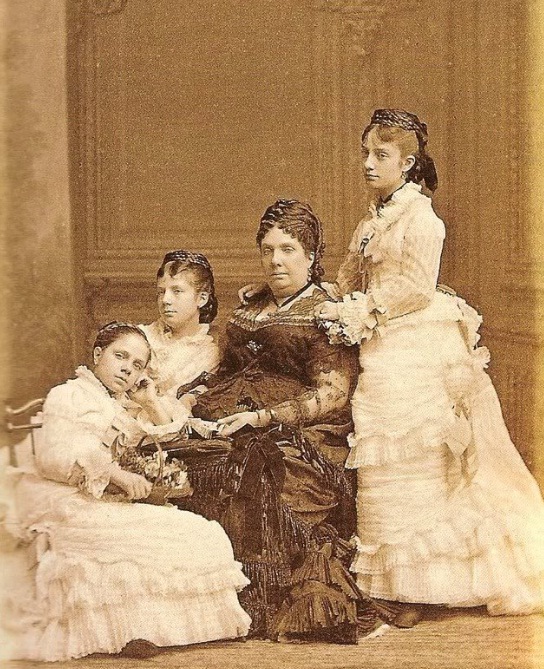by Susan Flantzer © Unofficial Royalty 2013

Queen Isabella II of Spain; Credit: Wikipedia
Queen Isabella II was born on October 10, 1830, at the Royal Palace in Madrid, Spain, the elder daughter of King Ferdinand VII of Spain and his fourth wife (and niece), Maria Christina of Bourbon-Two Sicilies. Isabella was baptized María Isabel Luisa and was Princess of Asturias, the title of the heir to the Spanish throne, from birth. In Spain, even if there is no heir apparent, the title can be (but is not necessarily) given to the heir presumptive – a daughter, sibling, or matrilineal descendant of the monarch. Ferdinand VII died on September 29, 1833, and Isabella succeeded to the throne, not quite three years old.
Isabella had one younger sister:
- Infanta Luisa Fernanda (1832 – 1897), married Antoine d’Orléans, Duke of Montpensier, had issue

Queen Isabella II as a child; Credit – Wikipedia
Ferdinand persuaded the Spanish legislature to set aside the Salic Law, which allowed only male succession. This precipitated a series of wars known as the Carlist Wars in which Ferdinand’s brother Carl, and later his descendants, fought over the succession. Even today, there are Carlist claimants to the Spanish throne. Isabella’s mother and Baldomero Espartero, Prince of Vergara, served as regents during her minority. In 1843, the military led a coup against Baldomero Espartero and then had the legislature declare that Isabella had reached her majority at age 13.
In a series of diplomatic twists and turns, called the Affair of the Spanish Marriage, Isabella married her double first cousin Infante Francisco de Asís de Borbón, Duke of Cadiz instead of the groom the English proposed, Prince Leopold of Saxe-Coburg and Gotha, a first cousin of Queen Victoria and her husband Prince Albert. At the same time, Isabella’s younger sister, Luisa Fernanda, married Antoine d’Orléans, Duke of Montpensier, the younger son of King Louis Philippe of France. These marriages pleased Louis Philippe and alienated the British.

Isabella and her husband; Credit – Wikipedia
Isabella’s marriage was not happy. There were persistent rumors that few, if any of her children, were fathered by her husband. Isabella had nine children, but only five reached adulthood.
Isabella’s children:
- Ferdinand (born and died 1850)
- Isabella, Princess of Asturias (1851 – 1931), married Prince Gaetan, Count of Girgenti, no issue
- Maria Cristina (born and died 1854)
- Alfonso XII, King of Spain (1857–1885), married (1) Maria de las Mercedes of Orléans, no issue; (2) Maria Christina of Austria, had issue, including King Alfonso XIII of Spain
- Maria de la Concepcion (1859–1861), died young
- Maria del Pilar (1861–1879)
- María de la Paz, Princess of Bavaria (1862–1946), married Prince Ludwig Ferdinand of Bavaria, had issue
- Francisco de Asis (born and died 1863)
- Eulalia, Duchess of Galliera (1864–1958), married Infante Antonio, Duke of Galliera, had issue

Isabella and her three youngest daughters; Credit – Wikipedia
Isabella’s authoritarianism, her religious fanaticism, her alliance with the military, and the chaos of her reign — sixty different governments — helped bring about the Revolution of 1868 that exiled her to Paris. The new government replaced Isabella with King Amadeo I, the second son of King Vittorio Emmanuele II of Italy. During Amadeo’s reign, there were many republican uprisings, and he abdicated in 1873 and returned to Italy. The First Spanish Republic was declared but lasted less than two years. Isabella officially abdicated in 1870, and after the First Spanish Republic collapsed, her son Alfonso XII became king.

Isabella in exile in Paris; Credit – Wikipedia
Isabella and her husband Francisco separated in 1870, but they both continued to live in France. Over time, they had become friends, and Isabella and two of her daughters were present when Francisco died in 1902. Isabella died from influenza complications in Paris, France, on April 10, 1904. Isabella and Francisco are buried in the Pantheon of Kings at the Royal Site of San Lorenzo de El Escorial in San Lorenzo de El Escorial, Spain, near Madrid, Spain.
This article is the intellectual property of Unofficial Royalty and is NOT TO BE COPIED, EDITED, OR POSTED IN ANY FORM ON ANOTHER WEBSITE under any circumstances. It is permissible to use a link that directs to Unofficial Royalty.
Kingdom of Spain Resources at Unofficial Royalty
- Kingdom of Spain Index
- Line of Succession to the Throne of Spain
- Monarchs of a United Spain (since 1516)
- Profiles of the Spanish Royal Family
- Spanish Royal Burial Sites
- Spanish Royal Christenings
- Spanish Royal Dates
- Spanish Royal FAQs
- Spanish Royal Links
- Spanish Royal Weddings
- Spanish Royal Residences

